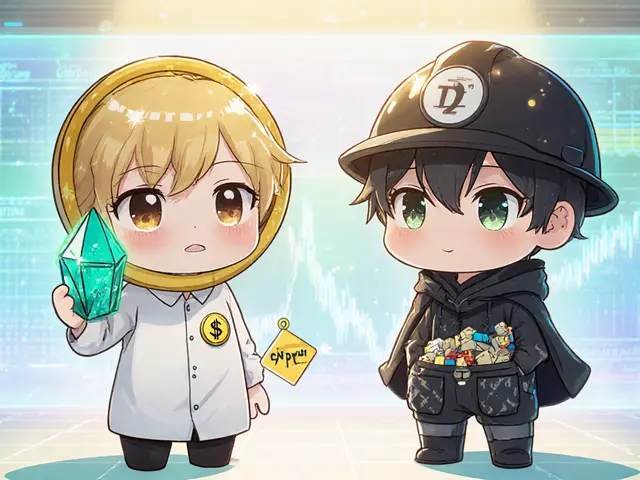SafeLaunch (SFEX) Airdrop Checker
Check Your SafeLaunch Airdrop Claim
Enter details about your airdrop claim to verify its legitimacy.
You've probably seen headlines about a mysterious SafeLaunch airdrop and wondered if it's worth chasing. The reality is a mix of scarce data, dead‑priced tokens, and a flood of scam tricks that litter the crypto world. In this guide we break down what SafeLaunch actually is, where its SFEX token sits today, how airdrops work in 2025, and the red‑flags you should watch before clicking any claim button.
TL;DR
- SFEX trades at $0 with zero 24‑hour volume - the token is effectively inactive.
- No official SafeLaunch airdrop has been announced by credible sources.
- Modern airdrops demand on‑chain activity, not just social media shares.
- Scam tokens often hide in wallet "Hidden" sections of wallets like Trezor Suite.
- Verify any claim through official channels, tokenomics docs, and active community chatter.
What is SafeLaunch and the SFEX Token?
SafeLaunch is a blockchain project that positions itself as a launchpad for new DeFi protocols. Its native crypto asset, the SFEX token, is meant to serve as both a utility and governance token within the ecosystem.
The token’s ticker is SFEX. According to public market aggregators, SFEX currently shows a price of $0 and a 24‑hour trading volume of $0, signaling either delisting, extreme illiquidity, or outright inactivity.
Current Market Status
Data from CoinMarketCap lists SFEX with a market cap of $0 and no active exchange listings. When a token lacks price discovery, any airdrop tied to it offers little to no real‑world value because there’s no place to swap the tokens for fiat or other crypto.
In practice, users who receive an inactive token often end up with a dust balance that sits idle, or worse, a malicious contract that can drain wallets when users attempt to approve a transfer.
Airdrop Landscape in 2025
The airdrop game has evolved dramatically. Projects like Meteora, Hyperliquid, and Pump.fun are running multi‑network campaigns that reward deep on‑chain engagement.
Typical qualification now includes:
- Providing liquidity on a DEX for a set period.
- Interacting with testnets or beta versions of protocols.
- Holding a minimum amount of a core token across supported chains.
How Modern Airdrops Are Structured
One of the most innovative frameworks is introduced by EigenLayer. Instead of rewarding mere social actions, EigenLayer distributes tokens to participants who restake assets to secure shared infrastructure. This approach ensures that airdrop recipients have a stake in the network’s health.
SafeLaunch has not publicly disclosed a similar point system, nor has it released a whitepaper outlining allocation percentages. Without that transparency, it’s hard to gauge the fairness or sustainability of any potential distribution.

Security Risks and Scam Tokens
Scam airdrops are rampant. Attackers flood wallets with bogus tokens that, when approved for transfer, let malicious contracts siphon all assets. Trezor Suite (version24.7.3) now automatically moves unknown tokens into a "Hidden" tab to protect users, but the danger remains if you manually approve any transaction.
Common red flags include:
- Unsolicited token appears in your wallet with no official announcement.
- The claim website asks for private keys or asks you to sign a transaction that grants "unlimited" approval.
- Zero‑price tokens that have no listings on reputable exchanges.
Verifying a SafeLaunch Airdrop
Before you even think about clicking a claim button, run through this checklist:
- Official Channels: Check SafeLaunch’s verified Twitter, Discord, and Medium accounts for an airdrop announcement. Look for pinned messages and the exact claim URL.
- Tokenomics Document: Legitimate projects publish a PDF or website page detailing total supply, allocation (e.g., % for community, % for airdrop), and vesting schedules.
- Community Activity: Browse the project’s Telegram or Reddit threads. Active discussions, developer AMA sessions, and regular updates signal genuine effort.
- Exchange Listings: Verify that SFEX appears on at least one reputable exchange (e.g., Binance, Coinbase, Kraken). Absence is a major warning sign.
- Smart Contract Audit: Look for audit reports from firms like CertiK or Quantstamp. If the airdrop contract isn’t audited, it could be a backdoor.
Failure to meet any of these criteria should make you walk away.
Comparison with Established Airdrop Programs
| Metric | SafeLaunch (SFEX) | SAFE (Safe Global) |
|---|---|---|
| Total Supply | Not publicly disclosed | 1billion tokens |
| Airdrop Allocation | Unclear, no official doc | 5% of supply (50million tokens) |
| Initial Airdrop Size | Unknown | 25million tokens (with vesting) |
| Current Trading Volume (24h) | $0 (inactive) | $8.8million+ |
| Audit Status | None publicly available | Audited by multiple firms |
| Community Presence | Sparse, limited official channels | Active Discord, Telegram, regular updates |
The contrast is stark. Established projects provide clear numbers, audited contracts, and vibrant ecosystems. SafeLaunch, on the other hand, looks like a ghost project when you dig into the data.
Recommendations for Potential Participants
If you still want to explore SafeLaunch, keep these pro tips in mind:
- Use a fresh wallet address solely for the airdrop. Never reuse a wallet that holds significant funds.
- Enable "Approve only once" settings in your wallet to limit exposure.
- Monitor the token’s price and volume for any change before attempting to sell.
- Stay updated via official SafeLaunch channels; if the team goes silent for weeks, pause any further interaction.
- Consider diversifying your airdrop hunt to projects with documented roadmaps, like EigenLayer or upcoming Layer‑2 launches.
In short, treat the SafeLaunch airdrop as a high‑risk experiment. The potential upside exists only if the team revives the token, lists it on an exchange, and proves its utility.
Next Steps & Troubleshooting
Should you encounter a claim page that looks legit but you’re still uneasy, follow this flow:
- Copy the URL and paste it into VirusTotal to scan for malicious scripts.
- Open the claim contract address on Etherscan and check the 'Contract' tab for any verified source code.
- If the contract is not verified, abort the transaction. Even if it is verified, read the code or use a service like Token Sniffer to flag potential rug pulls.
- After a successful claim, immediately transfer the tokens to a cold storage address and avoid approving any further interactions.
By staying skeptical and using these safety nets, you minimize the chance of ending up with a worthless or harmful token.
Frequently Asked Questions
Is the SafeLaunch airdrop still active?
There is no official announcement from SafeLaunch’s verified channels confirming an active airdrop. Most sources list the token as inactive, so proceed with extreme caution.
How can I tell if an airdrop token is a scam?
Look for red flags: unsolicited token drops, claim sites asking for private keys, zero‑price tokens, and lack of audit reports. Use wallet tools like Trezor Suite’s "Hidden" view to isolate unknown tokens.
What does the SFEX token’s $0 price mean for me?
A $0 price indicates no active market. Even if you receive SFEX, you won’t be able to sell or trade it until the token gains listings and liquidity.
Should I use a new wallet for the SafeLaunch airdrop?
Yes. Isolate any unknown airdrop tokens in a fresh wallet, keep the private key offline, and never approve contracts that you haven’t audited.
Where can I find reliable airdrop opportunities in 2025?
Projects like EigenLayer, Meteora, Hyperliquid, and other Layer‑2 initiatives publish detailed eligibility criteria on their official Discord or Medium pages. Stick to those with transparent tokenomics and audit reports.




Corrie Moxon
April 23, 2025 AT 13:30Sounds risky, better stay safe.
Jeff Carson
May 7, 2025 AT 10:50I’ve seen a few projects slip into the same pattern lately, so keep your eyes peeled 👀. The fact that SFEX shows zero volume and no exchange listings is a huge red flag. Always double‑check the official Twitter or Discord for a genuine announcement. If the claim site asks you to sign an unlimited approval, walk away immediately 😬. Trust your gut and the community chatter before you waste gas fees.
Anne Zaya
May 21, 2025 AT 08:10The guide nails the main points – no price, no legit channels, and that hidden token trap in wallets. Just remember: if you can’t find a verified audit, it’s probably not worth the hassle.
Emma Szabo
June 4, 2025 AT 05:30Let’s break this down step by step, because the SafeLaunch saga is a textbook case of how an airdrop can go sideways. First, the tokenomics are shrouded in mystery – there’s no public supply cap or allocation chart, which means you can’t even estimate the potential dilution. Second, the market data tells a stark story: $0 price, zero 24‑hour volume, and no listings on any reputable exchange, which essentially renders the token valueless for now. Third, the community signals are alarmingly quiet; the Discord shows sporadic posts and the Telegram has been dead for weeks, a sign that the core team may have gone radio‑silent. Fourth, the claim mechanisms being advertised ask users to approve contracts that could siphon assets – a classic rug‑pull vector that we’ve seen countless times in the wild. Fifth, the lack of an audit from firms like CertiK or Quantstamp means the smart contract could contain hidden backdoors, and without a verified source code you’re essentially signing your wallet’s fate. Sixth, even if the airdrop were legitimate, the absence of liquidity means you’d be stuck with dust that can’t be swapped, turning any “gain” into a storage problem. Seventh, the guide wisely suggests using a fresh wallet address, but many newcomers ignore that advice and end up exposing their main holdings. Eighth, tools like Token Sniffer and VirusTotal are indispensable; a quick scan can reveal malicious scripts before you interact. Ninth, the “Hidden” tab in wallets like Trezor Suite is there for a reason – treat any unknown token with extreme caution. Tenth, the broader market trend in 2025 favors point‑based airdrops that require real on‑chain activity, not simple social media check‑ins, making SafeLaunch’s approach look outdated. Eleventh, comparing SafeLaunch to projects like EigenLayer highlights the gap in transparency and utility. Twelfth, if the team decides to revive SFEX, they’ll need to secure at least one reputable exchange listing and publish audited tokenomics to regain trust. Thirteenth, until that happens, the safest play is to stay on the sidelines and focus on projects with clear roadmaps and community backing. Fourteenth, always remember that a token’s price is only as good as the market’s ability to trade it – $0 means no market. Fifteenth, in short, treat the SafeLaunch airdrop as a high‑risk experiment; the upside is speculative, and the downside could be a compromised wallet.
Fiona Lam
June 18, 2025 AT 02:50Honestly, this looks like a total scam, no point chasing dead‑weight tokens. If you’re not looking to get burned, steer clear and stop wasting gas fees.
OLAOLUWAPO SANDA
July 2, 2025 AT 00:10It’s plain and simple – no official word, zero price, no liquidity. That’s a red flag, walking away is the smart move.
Alex Yepes
July 15, 2025 AT 21:30In accordance with established best practices, the absence of a verifiable audit report should, without ambiguity, be considered a decisive factor in deeming the SafeLaunch airdrop unsuitable for participation. Moreover, the complete lack of exchange listings further corroborates the token’s illiquid status, thereby precluding any feasible exit strategy. Consequently, prudence dictates the avoidance of any transaction that would expose one’s wallet to potential malicious contracts. It is advisable to allocate resources toward projects that demonstrate transparent governance and audited smart‑contract code. Ultimately, discretion is the paramount virtue in this scenario.
Sumedha Nag
July 29, 2025 AT 18:50yeah, i think it’s just hype, don’t bother. there are better airdrops out there.
Holly Harrar
August 12, 2025 AT 16:10hey folks, just a heads up – if you decide to try the claim, make sure you use a brand new address and dont give any approvals that look sus. also, double check the contract on etherscan before you sign anything, k?
Vijay Kumar
August 26, 2025 AT 13:30I’ve seen a lot of similar situations, and the chill vibe is to stay calm, do the research, and move on if it feels off. No need to rush.
Edgardo Rodriguez
September 9, 2025 AT 10:50Considering, the multitude of indicators presented – zero price, lack of official announcement, absence of audit, minimal community engagement – one must, with due diligence, conclude that the SafeLaunch airdrop presents a significant risk, and accordingly, it is advisable to refrain from participation.
mudassir khan
September 23, 2025 AT 08:10Frankly, the entire premise is a textbook example of low‑effort token dumping; the documentation is nonexistent, the market presence is void, and the claim process is engineered to harvest signatures – a complete waste of time.
Bianca Giagante
October 7, 2025 AT 05:30While I understand the concerns raised, it is important to note, however, that not every project without a current market price is necessarily a scam; nonetheless, given the lack of verifiable information, exercising caution remains prudent.